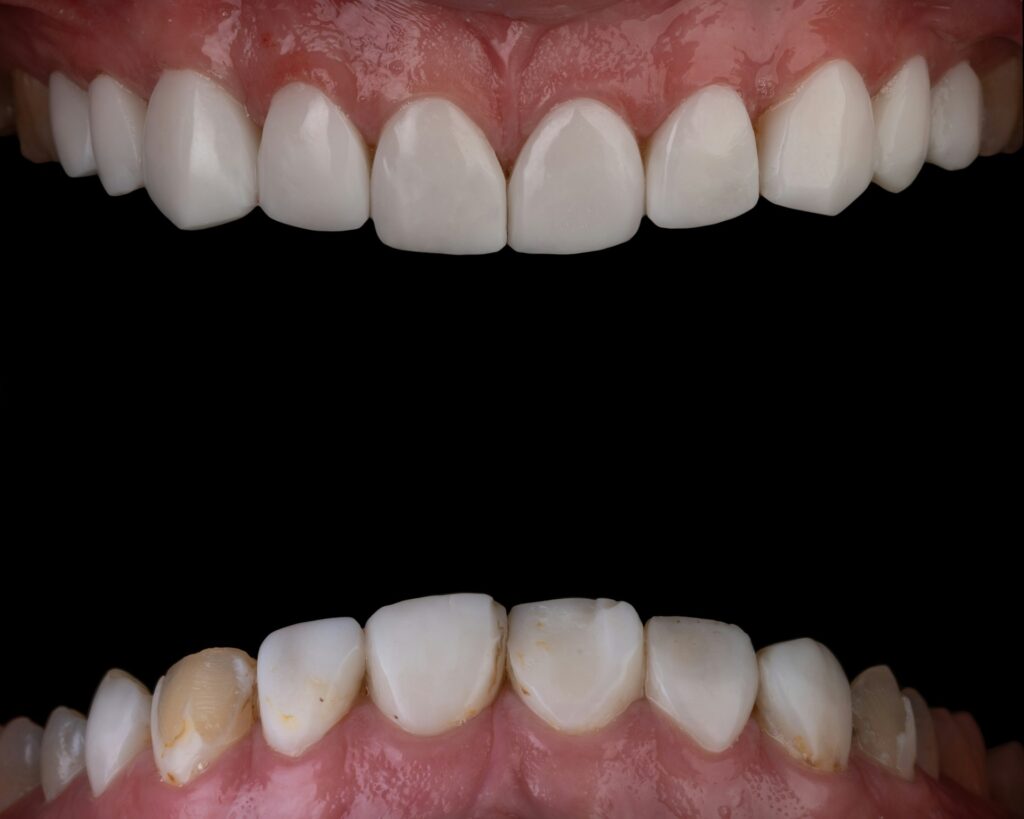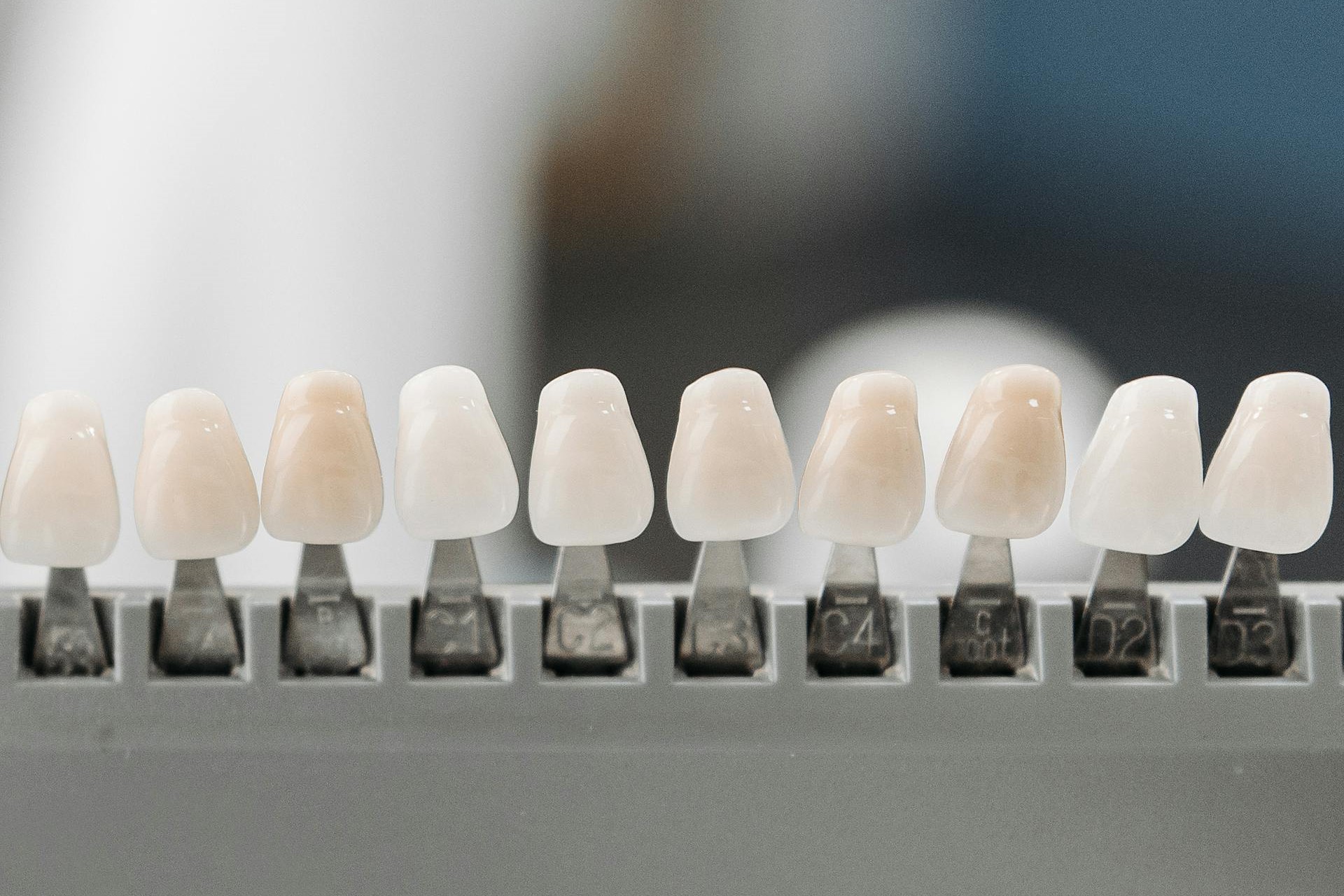
If you are interested in enhancing your smile and boosting your confidence, dental veneers may be an excellent solution for you. These thin shells made from porcelain or composite resin can effectively address a variety of dental concerns, including how veneers can fix gaps, chips, and discolouration, as well as unevenness.
This article will explore what veneers are, how they are applied, the different types available, and their respective advantages and disadvantages. Additionally, it will provide essential tips for caring for your new smile.
Discover how veneers can transform your teeth and elevate your overall appearance.
What Are Veneers?

Veneers are thin shells made from porcelain or composite materials, carefully designed to cover the front surfaces of teeth and enhance their appearance.
These cosmetic solutions are ideal for addressing imperfections such as gaps, chips, and discolouration, seamlessly blending with your natural teeth for a polished and radiant smile. While the cost of veneers may vary depending on the material and complexity of the treatment, their ability to deliver a significant aesthetic transformation makes them a popular choice for those seeking a complete smile makeover or targeted enhancements.
Understanding the options available ensures that individuals can achieve the best cosmetic results tailored to their needs and budget.
How Are Veneers Applied?
The process of applying veneers is a multi-step approach that demands careful planning and execution by dental professionals to achieve the best aesthetic outcomes and ensure patient satisfaction.
It starts with a consultation, during which patients can articulate their aesthetic goals and the specific concerns they would like to address, such as tooth alignment or imperfections in their smile.
After this initial discussion, the dentist will outline the necessary dental procedures. These may include preparing the teeth and taking impressions to create custom veneers that provide a perfect fit.
1. Consultation and Treatment Planning
The initial consultation is a crucial step in the veneer application process. During this phase, dental professionals assess the patient’s dental health while discussing their aesthetic preferences and goals for enhancing their smile. It is an opportunity for dentists to educate patients about various treatment options, including the benefits of veneers, potential outcomes, and any necessary dental procedures that could lead to optimal results.
Throughout this consultation, the dental team evaluates individual needs, taking into account factors such as tooth alignment, colour preferences, and lifestyle considerations that may influence the choice of veneers. They will explain the different types of veneers, such as porcelain and composite, ensuring that patients understand the distinct features and benefits of each option.
Setting realistic expectations is essential during this conversation. Dentists will outline the expected treatment duration, which can vary based on the complexity of the case, and discuss the anticipated cosmetic results.
This thorough dialogue not only fosters trust between the patient and the dental team but also enables patients to make informed decisions regarding their dental aesthetics.
2. Teeth Preparation
Tooth preparation is a vital step in the veneer process, involving the meticulous removal of a thin layer of enamel from the front surface of the teeth. This creates an ideal bonding surface for the veneers. Proper preparation ensures that the custom veneers fit correctly, align seamlessly with the biting surfaces, and prioritise both patient comfort and dental health throughout the procedure.
The removal of enamel is not only important for achieving a proper fit but also plays a significant role in the aesthetic result. It helps to prevent any bulky appearance that could occur if veneers were applied over excessive enamel. During this stage, dentists typically employ advanced bonding techniques to enhance the adhesion between the tooth and the veneer, which ultimately increases durability and longevity.
Special care is taken to ensure the patient’s comfort, as various anaesthetic options can be utilised to minimise any potential discomfort. By meticulously preparing the teeth, dentists lay the foundation for a successful veneer application while prioritising the long-term health of the patient’s smile.
3. Impressions and Customisation
After the preparation of the teeth, the subsequent step involves creating precise dental impressions, which serve as the foundation for crafting custom veneers tailored to each patient’s unique tooth shape and aesthetic preferences.
This customisation process is essential, as it ensures that the veneers not only match the natural colour of the surrounding teeth through effective colour matching but also fit seamlessly within the overall smile design.
The impressions effectively capture the intricate details of the teeth and gums, enabling dental technicians to produce veneers that fit flawlessly and enhance the patient’s smile harmoniously. These specialists play a critical role in interpreting the impressions and translating them into beautiful, functional veneers.
They utilise high-quality materials and advanced technology to bring the patient’s vision to life.
Aligning the final product with the patient’s aesthetic goals is of utmost importance. This collaboration guarantees that the resulting veneers meet both functional requirements and personal aspirations for a stunning, natural appearance that enhances confidence.
4. Temporary Veneers
While custom veneers are being crafted, patients typically receive temporary veneers. These serve to protect their prepared teeth and help maintain an aesthetically pleasing appearance. Temporary solutions are essential for ensuring patient comfort during the waiting period and allow individuals to preview their smile transformation.
Along with protecting the underlying tooth structure from sensitivity and potential damage, these provisional veneers can also enhance the overall cosmetic appearance during the process. By mimicking the shape and colour of the final veneers, they enable patients to adapt to the new smile aesthetic, fostering both confidence and comfort.
This transitional period not only protects the prepared teeth but also plays a vital role in allowing dentists to make any necessary adjustments to the shape or fit of the final porcelain. Therefore, temporary veneers are a crucial component in overseeing the entire veneer application journey.
5. Bonding and Final Placement
The final placement of veneers involves a meticulous bonding process, during which a strong adhesive is used to attach the custom veneers securely to the teeth. This step is critical for achieving both the desired aesthetic outcome and maintaining optimal dental health. Proper placement of veneers can help prevent issues such as tooth sensitivity and enamel damage.
A key consideration for patients is understanding that veneers are not reversible, as the process often involves removing a thin layer of enamel to ensure a proper fit. This permanent alteration makes it essential for individuals to weigh their options carefully before committing to the procedure.
During the bonding process, techniques such as etching the tooth surface to enhance adhesion and applying a dual-cure resin adhesive ensure a strong and lasting bond. Post-application care is equally important for extending the lifespan of the veneers. Maintaining good oral hygiene practices, such as using non-abrasive toothpaste and a soft toothbrush, can protect the veneer surface.
Additionally, avoiding habits like teeth grinding or biting on hard objects is vital for preserving the integrity of the veneers, ensuring they continue to enhance the patient’s smile for years to come.
What Problems Can Veneers Fix?

Veneers serve as a versatile solution in cosmetic dentistry, effectively addressing various dental concerns that can impact the overall quality of one’s smile.
Whether it’s closing gaps between teeth or repairing chipped or broken teeth, veneers offer a proactive approach to correcting smile imperfections. They not only enhance dental aesthetics but also play a significant role in boosting a patient’s confidence.
1. Gaps Between Teeth
One of the key issues that veneers can effectively address is the presence of gaps between teeth, which can detract from an otherwise attractive smile. With gap closure techniques, veneers can create a seamless transition between teeth, enhancing overall tooth alignment and contributing to a more aesthetically pleasing smile design.
By filling these spaces, veneers not only improve visual appeal but also help balance the proportions of an individual’s smile, resulting in a more harmonious and fuller appearance. This transformation can significantly impact one’s confidence and self-esteem, as many people find that a well-aligned smile, free from gaps, tends to look more youthful and vibrant.
Ultimately, opting for veneers to close gaps can be a transformative decision, leading to enhanced aesthetics and a greater willingness to share one’s smile with the world.
2. Chipped or Broken Teeth
Chipped or broken teeth can greatly affect both your smile and overall dental aesthetics, but veneers offer an effective solution for repairing these issues. By covering the damaged surfaces of the teeth, veneers restore their appearance and enhance the overall cosmetic appeal of your smile.
These thin shells, often crafted from porcelain or resin composite, are custom-designed to fit seamlessly over the affected teeth, integrating beautifully with the surrounding dental structure.
The process typically starts with a consultation, during which the dental professional evaluates the extent of the damage and discusses your desired outcomes. After preparing the tooth by removing a small amount of enamel, impressions are taken to create personalised veneers.
Once applied, veneers not only conceal imperfections but also provide additional strength and protection to the underlying tooth, transforming not just individual teeth but also improving the entire smile profile.
3. Discoloured or Stained Teeth
For those encountering issues with tooth discolouration or persistent stains, veneers present an outstanding alternative to traditional teeth whitening methods. The application of veneers not only conceals discolouration but also delivers a long-lasting aesthetic enhancement that significantly improves the overall appearance of the teeth.
In contrast to many whitening procedures, which often necessitate multiple sessions and may yield only temporary results, veneers provide a durable solution that resists staining and offers a naturally bright appearance. Patients frequently appreciate that veneers can be custom-designed to match their desired shade, ensuring they blend seamlessly with their existing teeth.
This tailored approach not only guarantees a consistently radiant smile but also boosts confidence in social situations, contributing to a positive self-image.
With veneers, the emphasis shifts from simply removing stains to achieving a beautiful and healthy-looking smile that endures for years to come.
4. Misshapen or Crooked Teeth
Misshapen or crooked teeth can lead to alignment issues that impact not only your smile but also your overall dental health. Veneers offer an effective solution for reshaping and realigning these teeth, providing significant aesthetic improvements and contributing to a more harmonious smile.
These thin shells, usually made from porcelain or composite resin, are meticulously crafted to fit over the front surfaces of the teeth, transforming their appearance in just a few hours. When individuals choose to get veneers, they often experience a boost in confidence from their enhanced smile, alongside a reduction in potential dental issues stemming from misalignment.
The precision of veneers results in a smooth and uniform appearance, which makes it easier for individuals to maintain proper oral hygiene. With improved smile alignment, many find themselves approaching social situations with renewed confidence, feeling more self-assured and ready to express themselves without hesitation.
5. Uneven or Worn Teeth
Uneven or worn teeth can detract from the overall beauty of one’s smile, making veneers an excellent solution for restoring balance and uniformity. By applying veneers to these teeth, individuals can achieve a more consistent appearance, ultimately leading to improved aesthetic outcomes.
These thin, custom-made shells are bonded to the front surface of the teeth, effectively addressing issues such as chips and gaps, while also enhancing overall facial symmetry. When properly cared for, veneers can offer a long-lasting solution that helps preserve the brightness and smoothness of one’s smile.
It is essential for individuals to commit to good oral hygiene practices, attend regular dental check-ups, and make mindful dietary choices to maintain the beauty and integrity of their veneers over time.
This dedication ensures that the results remain vibrant, allowing the smile to continue radiating confidence.
What Are the Types of Veneers?

When considering veneers, it is important to understand the different types available to achieve the most aesthetically pleasing results for your smile.
The two most common types are porcelain veneers and composite veneers. Each of these options has unique characteristics that cater to various dental aesthetics and patient needs.
1. Porcelain Veneers
Porcelain veneers are widely recognised for their durability and natural appearance, making them an appealing option for individuals seeking long-lasting aesthetic improvements. Made from high-quality ceramic material, these veneers offer excellent biocompatibility and blend seamlessly with the natural tooth structure.
Along with their physical attributes, porcelain veneers significantly enhance overall dental aesthetics. Many patients discover that these veneers can transform their smiles by effectively concealing imperfections such as discolouration, gaps, or minor misalignments. This transformation not only enhances self-confidence but also inspires individuals to prioritise their oral health, resulting in better hygiene practices.
Furthermore, porcelain veneers are designed to reflect light in a manner that closely mimics natural teeth. This quality ensures a bright, vibrant smile that can enhance one’s appearance and leave a lasting impression.
2. Composite Veneers
Composite veneers present a versatile and cost-effective solution for individuals aiming to enhance their smiles without undergoing extensive dental procedures. These veneers can be applied directly to the tooth surface, resulting in a quicker process and immediate aesthetic improvements.
In contrast to porcelain veneers, which often necessitate multiple visits to the dentist and can carry a higher price tag, composite veneers are typically completed in a single appointment. This makes them an attractive option for those seeking a swift and budget-friendly remedy for dental imperfections such as chips, discolouration, or gaps.
Moreover, composite materials can be easily sculpted and adjusted by the dentist, allowing for a more personalised approach to achieving the desired smile. For patients who require minimal alteration or may not be ready to commit to more permanent solutions, composite veneers strike an ideal balance between beauty and practicality.
3. Lumineers
Lumineers offer a groundbreaking approach to cosmetic dentistry by providing a non-invasive procedure that necessitates minimal enamel removal compared to traditional veneers. This innovative option enables patients to achieve stunning results without compromising the integrity of their tooth structure, making Lumineers a preferred choice for those seeking a gentler alternative.
What distinguishes Lumineers is their remarkable thinness—typically around 0.2 millimetres—which not only helps create a remarkably natural appearance but also ensures durability.
The application process is relatively simple, typically requiring just two visits: one for the consultation and impression-taking, and a second for the actual placement. This streamlined process not only minimises discomfort but also significantly reduces the time spent in the dental chair.
Furthermore, Lumineers demand very little maintenance compared to traditional veneers, as they resist staining and do not require special adhesives. These attributes make Lumineers a preferred option in the field of modern cosmetic dentistry.
What Are the Pros and Cons of Veneers?
When considering veneers, it is important to carefully weigh the pros and cons to make an informed decision regarding your dental procedures.
Veneers can provide outstanding aesthetic results and significantly boost confidence for many patients. However, there are also important factors to consider, including maintenance, durability, and cost.
1. Pros of Veneers
The advantages of veneers are quite impressive, ranging from their ability to deliver stunning aesthetic results to the significant boost in confidence they provide to patients. Veneers can effectively conceal various dental imperfections, leading to remarkable cosmetic improvements and an enhanced overall appearance.
These custom-made dental shells not only hide discolouration and chips but also create a uniform and harmonious smile that complements one’s facial features. The minimally invasive nature of veneer placement makes them an attractive option for many individuals, allowing them to achieve their desired smile without the need for extensive procedures.
Patients frequently report a noticeable increase in self-esteem and a greater willingness to engage in social situations following their treatment, underlining how veneers can transform lives in ways that extend beyond aesthetics.
The versatility of veneers ensures they can meet a wide range of preferences and needs, solidifying their reputation as a preferred solution for achieving dental perfection.
2. Cons of Veneers
While veneers offer numerous benefits, it is important for potential patients to consider some drawbacks before proceeding with treatment. The cost of veneers can be considerable, and proper maintenance is vital to ensure their longevity. Additionally, there may be concerns regarding tooth sensitivity and overall dental health.
For those considering this cosmetic dental option, it is essential to evaluate the financial implications, as the initial investment can be quite significant and might not be covered by insurance. Ongoing maintenance is also required, which can contribute to the overall expense over time.
Moreover, potential side effects such as tooth sensitivity can occur, making it uncomfortable for individuals to enjoy hot or cold food and drink.
Before making any decisions, it is advisable for patients to discuss these concerns thoroughly with their dental professionals. This ensures that they make a well-informed choice that aligns with their long-term oral health goals.
How to Care for Veneers?

Caring for veneers is crucial for ensuring their longevity and maintaining the aesthetic appeal achieved through their application. It is important to establish a solid oral hygiene routine and schedule regular dental check-ups.
These practices play a vital role in preserving both the veneers and the natural teeth underneath.
1. Practice Good Oral Hygiene
Practising good oral hygiene is essential for maintaining both your veneers and your overall dental health. Regular brushing and flossing play a crucial role in preventing plaque build-up and ensuring that the area around your veneers stays clean, which contributes to their durability and longevity.
Incorporating specific dental products, such as a soft-bristled toothbrush and fluoride toothpaste, can enhance the care of your veneers. It is advisable to select a non-abrasive toothpaste to prevent scratching the veneer surface, helping them maintain their smooth shine.
Using an antibacterial mouthwash can further eliminate harmful bacteria, promoting a healthier oral environment. Additionally, interdental brushes or flossing aids can effectively clean between your veneers and natural teeth, preventing food particles from becoming trapped.
These practices not only protect your dental investments but also support the overall health of your natural teeth, leading to a harmonious balance in your smile.
2. Avoid Bad Habits
Avoiding bad habits is essential for maintaining the integrity of your veneers and ensuring their longevity. Engaging in activities such as teeth grinding or using your teeth as tools can cause damage or premature wear, undermining the aesthetic results you wish to achieve.
Furthermore, habits like biting down on hard objects—think ice or pens—can chip the veneers, resulting in potentially costly repairs. Additionally, poor oral hygiene practices, such as neglecting regular brushing and flossing, can lead to gum disease, which poses a risk to the health of your veneers.
To address these concerns, it is advisable to establish a nightly oral care routine that includes using a soft-bristled toothbrush and a gentle toothpaste. Consulting with a dental professional about the use of a mouthguard during sleep can effectively prevent grinding while also protecting your investment in your smile.
3. Schedule Regular Dental Check-ups
Scheduling regular dental check-ups is a crucial aspect of veneer care, as it allows dental professionals to monitor the condition of your veneers and address any potential issues before they escalate. These examinations are fundamental for ensuring patient comfort and maintaining optimal dental health.
During these visits, patients can expect comprehensive evaluations that encompass assessments of tooth health, alignment, and the structural integrity of the veneers. Additionally, the dentist may conduct professional cleanings to eliminate plaque and tartar buildup, which, if neglected, can lead to decay and gum disease.
These routine appointments not only enhance the longevity of veneers but also reinforce overall oral hygiene practices. By prioritising these check-ups, individuals can reap the benefits of their veneers for many years, ensuring their smiles remain both beautiful and healthy.
Frequently Asked Questions on How Veneers Can Fix Gaps, Chips, and Discolouration
How can veneers fix gaps between my teeth?
Veneers are thin, custom-made shells that are bonded to the front of your teeth. They can effectively cover and close gaps between teeth, giving you a more even and uniform smile.
Can veneers fix chips in my teeth?
Yes, veneers can fix chips in teeth by covering and hiding the damaged area. The veneers are made to match the shape and color of your natural teeth, providing a seamless and natural-looking fix for chipped teeth.
Will veneers fix discolouration on my teeth?
Veneers are a great solution for discolouration on teeth. They can cover up stains and discoloration that cannot be removed through traditional teeth whitening methods. Veneers are also stain-resistant, meaning your new smile will stay bright and white.
How long do veneers last?
Veneers have a lifespan of around 10-15 years, but with proper care and maintenance, they can last even longer. It’s important to follow good oral hygiene practices and avoid habits like teeth grinding to ensure the longevity of your veneers.
What is the process for getting veneers?
The first step is a consultation with a dentist to discuss your desired results and determine if veneers are the right option for you. If so, your dentist will take impressions of your teeth and send them to a lab for custom veneers to be made. Once the veneers are ready, your dentist will prepare your teeth and bond the veneers in place.
Are veneers a permanent solution?
Veneers are considered a permanent solution, as they require some of the tooth’s enamel to be removed in order to place them. However, they may need to be replaced or repaired in the future due to natural wear and tear or damage.






